Abstract
The pore-throat network of rock exerts a vital influence on the permeability and mechanical properties of the rock. Resorting to X-ray micro-CT scanning, the present work investigates the pore-throat structure of marine biogenic carbonate samples from the South China Sea and compares them to terrigenous sedimentary sandstone. With the help of the maximum ball (MB) algorithm, the pore-throat networks inside representative elementary volumes of rock samples are revealed by stick-and-ball diagrams, which enables quantitative analyses afterwards. Higher and more deviant cross sectional porosity was observed for the carbonate samples compared to the sandstone sample, indicating relatively heterogeneous pores in the carbonate. Over 85% of pores in the carbonate samples were classified as mesopores. Irregular triangular cross sections can be inferred for the pores and throats of the carbonate. The type of rock and the porosity seem to have little effect on the shapes of the pores and throats. In the studied carbonate, the average volume of the throat was approximately one order of magnitude smaller than the average volume of a pore. The distribution of throat radius differed significantly between the studied carbonate samples. The average coordination number of the carbonate was measured to be 1.
1. Introduction
Represented by a lattice of pores connected by throats, the void in rock masses has a fundamental impact on the physical and mechanical properties of the rock. Sedimentary rock mass is mainly composed of pores and solid parts. To evaluate the reservoir properties of sedimentary rock, a quantitative analysis in terms of the pore morphology is required, which entails the characterization of both the dimensions and shapes of the pores and the connecting throats. Ehrlich et al. [] performed characterization studies on the microstructure of rock masses and analyzed the spatial arrangement of pores and solids on the rock slices. Thanks to the development of image processing technologies, scanning electron microscopy and image processing technologies were applied to quantitatively reveal the pore structure of geotechnical materials [,,]. Xie et al. [] tried to quantify the pore morphology of different carbonate samples based on the digital analyses of two-dimensional images from thin sections taken under the environmental scanning electron microscope (ESEM). The effect of the pore morphology on the porosity and permeability was also discussed. Zhu et al. [] applied femtosecond laser cutting so as to look into the intrapore structures of calcareous sand grains of various sizes. As they concluded, small pores outnumbered large pores and the former prevailed in terms of volumetric fraction. Du et al. [] applied X-ray diffraction, scanning electron microscopy and mercury intrusion porosimetry to study the effect of zinc (Zn) concentration on the pore-size distribution of zinc-contaminated kaolin clay when the clay was stabilized by a cement additive. X-ray tomographic imaging and relevant analytic technologies were also applied to study the multiphase flow and displacement inside a porous material [].
In recent years, significant improvement has been made with regard to the X-ray light source technology in CT scanning. Meanwhile, driven by oil and gas exploration, pollutant migration, coal mining, and the geological storage of CO2, high-resolution industrial CT has been increasingly used to reveal the pore morphology of rocks [,,]. The application of CT technology enables researchers to look into the microstructures of geotechnical materials [,,,,]. Wu et al. [] applied the mercury injection capillary pressure (MICP) test, nuclear magnetic resonance (NMR), scanning electron microscopy (SEM) and X-ray computed tomography (CT) to investigate the geometry and topology of the pore network of low permeability carbonate cap rocks, during which the CT scanning proved to be competent to characterize the geometry, topology and fractal dimension of the pore network in the rocks.
In other developments, X-ray computed tomography (CT) was applied to investigate the damage cracking behavior of rock and soil aggregate (RSA) under uniaxial compressive loading []. Raeini et al. [] proposed a finite volume-based methodology for the analysis of two-phase flow using micro-CT images of porous media.
In summary, the primary advantage of CT scanning is to image a sample in a three-dimensional and non-destructive manner. It uses X-rays to create cross-sectional pictures (“slices”) of the sample. The slices can either be displayed individually in two dimensional form or stacked together to generate a 3D imaging that can reveal the internal structure of the sample. Furthermore, with the help of relevant softwares and algorithms such as Avizo, VGStudio MAX and Pore3D, quantitative 3D analysis can be performed for certain features of interest for the sample. In geoscience, the features of interest include the pore characteristics, morphological characteristics, mineral composition, crack propagation, fluid flow analysis and the reconstruction of fossils [].
The present work studies the pore network of two types of sedimentary rocks, i.e., carbonate rock and sandstone. The pore structure of sedimentary rocks varies due to different diagenesis and mineral composition. Assessing the pore structure of sedimentary rocks can facilitate the exploration of oil and gas in sedimentary rock reservoirs [,]. As a type of marine sedimentary rock, carbonate rocks are featured by high porosity and permeability. Carbonate rocks commonly contain a variety of pore types whose sizes span several orders of magnitude [,,,]. Pore systems in sedimentary carbonates are complex in terms of their geometry and genesis, and differ remarkably from those of sandstones []. The present work applies X-ray micro-CT scanning technology to reveal the pore-throat structures of the marine carbonate rocks (sampled from Nansha Islands in the South China Sea, within 400 m from the coral reef surface, numbered from shallow to deep according to the depth of sampling) and the terrigenous sandstone, respectively in order to shed light on the permeability and evolution of sedimentary fabrics for carbonate rocks.
2. Microfacies Analysis
The microfacies of carbonate samples A, B, C, D, E and sandstone S were obtained using polarizing microscopy (see Figure 1). Reef limestone samples are composed of bioclast, which mainly includes coral, coralline algae and foraminifera. However, the type of cement for the carbonate samples is different. Samples A, B, C and E are cemented by argillaceous crystals, while sample D is cemented by crystal calcites. Only sample E is partially dolomitized.
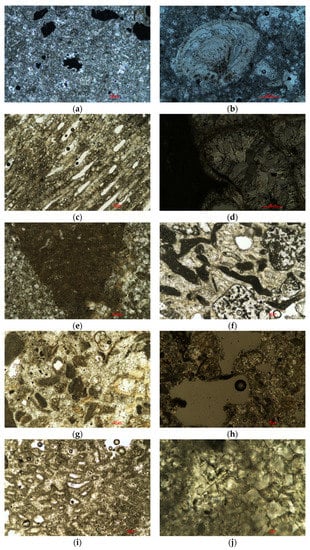

Figure 1.
Microfacies analysis of thin sections of rock samples. (a) Carbonate A: bioclast. (b) Carbonate A: foraminifera. (c) Carbonate B: coral. (d) Carbonate B: calcite filled. (e) Carbonate C: coralline algae. (f) Carbonate C: microbial erosion. (g) Carbonate D: crystal calcites. (h) Carbonate D: dissolved pores. (i) Carbonate E: coral. (j) Carbonate E: dolomitization. (k) Sandstone S: sedimentary particles. (l) Sandstone S: oxidation zone.
Sample S is an aeolian ferruginous sandstone with angular grains and bimodal particle sizes (ca. 200 and 100 μm). The grains are not supported and the interstitial material is silt-sized. The larger particles are iron oxide.
3. X-ray Micro-CT Scanning Test
3.1. Test Samples
Five different samples of the reef limestones, all of which were marine biogenic carbonates, were chosen for study in the present work. To obtain the samples, a single drilling was performed on the Nansha Islands in the South China Sea. After segmentation, the drill cores at five different depths were chosen and morphed into standard cylinders with a diameter of 50 mm and a height of 100 mm through cutting and polishing. The five samples were labeled as A, B, C, D, and E according to their depth of sampling. For comparison, an extra cylindrical sample was made out of a sandstone, which is terrigenous sedimentary rock. The extra sample was labeled as S. Figure 2 shows the test samples in the present work. The machining accuracy regarding the dimensions of the samples met the requirements of the International Society for Rock Mechanics []. Table 1 lists the dimensions and densities of the rock samples.
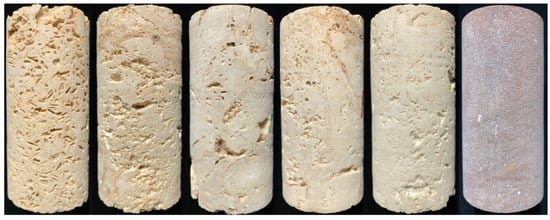
Figure 2.
Standard cylinder specimens, from left to right are carbonate A, B, C, D, E and sandstone S.

Table 1.
Sample size.
3.2. Equipment and Test Condition
In CT-scanning technology, the voltage of the X-ray tube determines the photon energy of X-ray harnesses. The higher the voltage of X-ray tube, the higher the X-ray penetration. On the premise that other scanning parameters are constant, increasing the voltage of the X-ray tube can significantly increase the physical dose of X-ray and reduce the standard deviation (SD), so as to improve the image quality and image resolution.
Figure 3 shows the X-ray micro-CT scanner (nanoVoxel-4000, Tianjin Sanying Precision Instrument, Tianjin, China) used in the present work. When scanning the carbonate rock, the resolution of the image was set to 61.75 μm with the voltage of X-ray tube set to 180 kV. However, the aforementioned settings were not feasible for the sandstone sample as the obtained images were blurred. This is because the X-rays are unable to penetrate the sample due to the compaction of grains in the sandstone. Therefore, a higher resolution of imaging (30.45 μm) and a higher voltage of X-ray tube (200 kV) were adopted when scanning the sandstone sample.
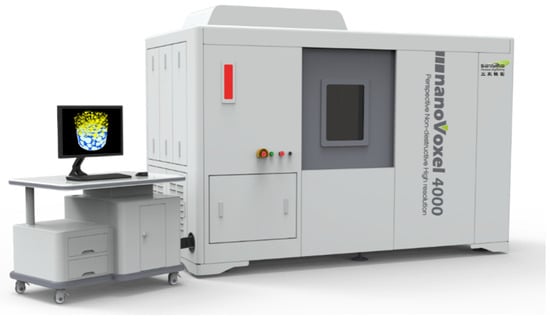
Figure 3.
High resolution X-ray micro CT.
The samples were scanned in the directions of X, Y, and Z, with Z being the longitudinal direction of the cylinders. The positive directions of X, Y, and Z axes follow the right-hand rule.
As aforementioned, the resolution of the imaging in the X, Y, and Z axes, i.e., the distance between adjacent slices (cross-sectional pictures), was set to 61.75 μm for the carbonate samples and 30.45 μm for the sandstone sample. Scanning a single rock sample took approximately 1 h with an operating current of 150 μA. A total of around 3200 cross-sectional pictures were obtained for each carbonate sample while scanning the sandstone sample generated 6430 cross-sectional pictures.
3.3. Test Principle
In high-resolution X-ray micro-CT, a cone-shaped X-ray emits from a microfocus ray source and penetrates the specimen before reaching the detector. In the meanwhile, either the X-ray source and the detector remain stationary during the scan while the specimen rotates or the specimen stays stationary in space while the X-ray tube and the detector rotate around. The reduction of the intensity of an x-ray beam as it traverses matter (i.e., the attenuation) is collected and used to infer the internal structure of the specimen.
The raw files from CT scanning are then imported into data visualization and analysis softwares such as Dragon fly (Object Research Systems, Montréal, QC, Canada) and Avizo (Thermo Fisher Scientific, Waltham, MA, USA) to enable 3D reconstruction of the sample. The 3D reconstructed model can depict the internal structure of the specimen. As for the rock samples in this work, features including the internal pore network and the fabrics can be extracted from the reconstructed samples.
As a non-intrusive, fluoroscopic and high-resolution imaging technology that supports 3D reconstruction, CT scanning enables viewing of the microstructural features of a specimen. The gray-level details of obtained CT images reflects the relative density inside the sample.
3.4. Cross Sectional Porosity
For each slice from CT scanning, the cross sectional porosity, which is defined as the ratio between the number of pixels representing porosity and the overall number of pixels representing the cross section, can be evaluated. As illustrated in Figure 4, a layer by layer cross-sectional porosity analysis was performed on each two-dimensional section along the Z axis. It is worth noting that the cross sections were not ideally circular for the carbonate samples due to the surface open pores. Therefore, in the calculation of cross sectional porosity, the overall area of the cross section was determined using a circular fitting profile, whose diameter was determined to be the average distance between pairs of centrosymmetric (with regard to the Z axis) pixels on the actual profile of the cross section except the open pores.
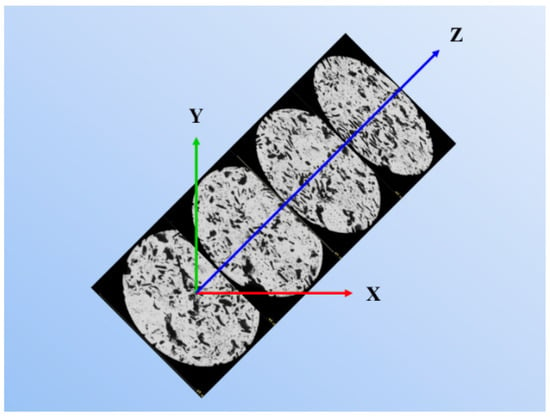
Figure 4.
Illustration of cross sections along the Z axis for the cylindrical test samples.
Now that the number of obtained cross sections are different for the carbonate and sandstone samples due to different resolutions of scanning, around 800 cross sections that were equally spaced along the Z axis were chosen for each sample for the evaluation of the cross-sectional porosity. Figure 5 illustrates the distribution of cross-sectional porosity along the Z axis for all the samples. Note that the cross sections in all the samples are indexed consistently so that the cross sections with the same index share approximately the same height in the samples.
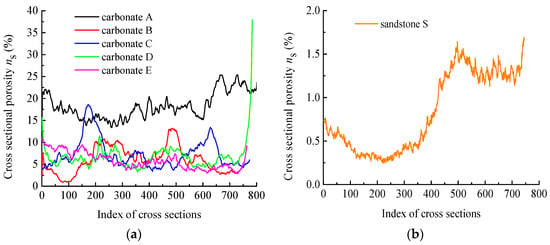
Figure 5.
Distribution of cross sectional porosity along the direction of Z axis. (a) Carbonate. (b) Sandstone.
As is shown in Figure 5, much higher cross-sectional porosity was observed for the carbonate samples compared to the sandstone sample. Moreover, the deviation of cross-sectional porosity along the Z axis was more severe for the carbonate samples. This demonstrates the complex forming process of carbonate rocks, as the randomness of the sedimentary particulates and the heterogeneity of the diagenesis process result in anisotropic pore structures. In contrast, small and less deviative cross-sectional porosity was observed for the sandstone sample, indicating relatively uniform and dense internal structure. It is noteworthy that the peaks in the distribution of cross-sectional porosity of Figure 5 imply large pores that span multiple adjacent cross sections. Therefore, how the cross-sectional porosity evolves along the Z axis reflects the change of porosity inside the specimen, which can identify large pores in the sample in a non-disruptive manner.
4. Microstructural Analysis
4.1. 3D Reconstruction and Analysis
Images of the cross sections of specimen, as shown in Figure 6, are obtained when CT scanning is performed along different directions. In each cross sectional image, pixels with different gray levels indicate pores and solids. To reconstruct the 3D model of pores and solids in the specimen out of the cross sectional images, Dragon fly (Object Research Systems, Canada) was applied.
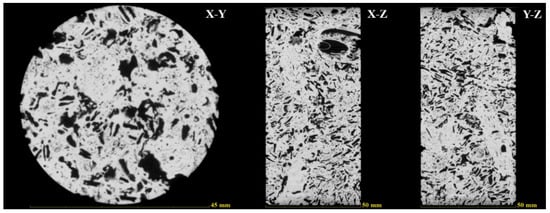
Figure 6.
Cross sectional images of sample A when scanning along Z, Y, X axes.
Figure 7a shows the 3D reconstructed model of the cylindrical sample A, from which the 3D models of the pore network (see Figure 7b) and the solid phase (see Figure 7c) can be extracted. As a result, the volumetric fractions of the pore and the solid can be determined and they are listed in Table 2 for all the samples.

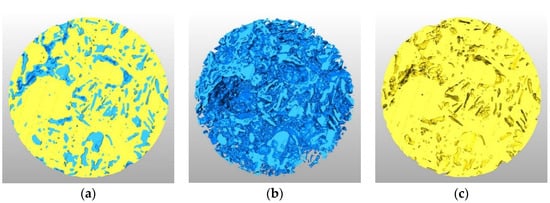
Figure 7.
The 3D reconstructed model of sample A. (a) Total. (b) Pore network. (c) Solid.

Table 2.
Volumetric fractions of pore and solid in the rock samples.
4.2. Digital Core Analysis
Moreover, the representative elementary volume (REV) of arbitrary size (larger than the spatial resolution of CT) can be placed inside the 3D reconstructed model of the whole specimen. The extraction of pore and solid can then be performed for the REV in the same manner as it is done for the whole specimen. In the present work, three REVs, each of which was sized 400 pixels × 400 pixels × 400 pixels, were placed in three different positions for each sample (see Figure 8). Note that the actual size of the REV depends on the resolution of the CT scan. For the sandstone sample, whose resolution of scan was 30.45 μm, 4003 voxels corresponded to an actual volume of 12.183 mm3. The carbonate samples, for which the resolution of scan was 61.75 μm, 4003 voxels corresponded to an actual volume of 24.73 mm3. In the reconstructed model, the pore network was represented by a stack of voxels. Higher scan resolution leads to smaller voxels and a more refined representation of the pore network. As is shown in Figure 9, extraction of the pore network and the solid part could be performed for each REV, based on which further geometrical and morphological analysis could be conducted.
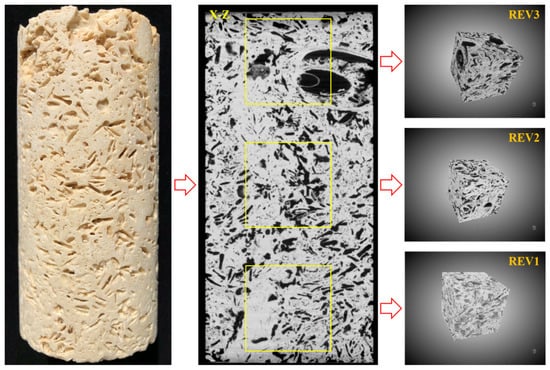
Figure 8.
Representative elementary volumes (REV) that are chosen for each test sample.
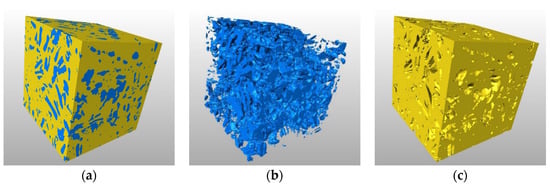
Figure 9.
The 3D reconstructed model of REV2 of sample A and the extraction of pore network and solid. (a) Total. (b) Pore network. (c) Solid.
Table 3 lists the volumetric fractions of pores for all the REVs. Due to the complex diagenesis process of carbonate rock, the pores are heterogeneously distributed in the specimen, resulting in quite different porosity readings among the REVs that were sampled from different positions of a specimen. The porosity that was measured from the 3D REVs was more intuitive compared to the cross sectional porosity in Section 3.4, when it came to revealing the volume and distribution of pores. A combination of the cross-sectional porosity and the REV porosity could help locate large pores in the specimen.

Table 3.
Porosity of REVs.
4.3. Pore Scale Network Model
The pore network plays a vital role in determining the permeability and the storage capacity of rock masses. As trailblazing work, Fatt [] proposed the modeling of porous media using a network of tubes when deriving capillary pressure curves. Based upon this concept, two different methods were proposed by researchers to model the network of pores in porous media. In the first method, 3D images of porous media are obtained from process-based reconstructions and X-ray microtomography. Then the complete pore network representations are extracted from the 3D images. It is applied to the study of both sandstones and carbonates []. The second method is a process-based method for reconstructing the full three-dimensional microstructure of sandstones, which includes the network of pores. It utilizes petrographical information obtained from two-dimensional thin sections to stochastically model sandstone forming processes—sedimentation, compaction, and diagenesis. It was shown that the process-based reconstruction was able to reproduce adequately accurate properties of the sandstone []. However, the sedimentary process of carbonate rocks can be too complicated for the process-based method. Therefore, the network of pores in carbonate rocks need to be extracted from 3D images, for which algorithms that extract simplified networks of pores and throats with parametrized geometry and interconnectivity are indispensable. Among the algorithms that extract topology from 3D images of porous media, the maximum ball algorithm is the most widely used one.
Being initially proposed by Silin et al. [,], the maximum ball method produces a stick-and-ball diagram of the pore network. The balls and sticks are used to represent the “pore bodies” and “pore throats”, through which their respective volumes and connectivity are established. The balls and the sticks thus indicate the porosity and the permeability of the porous media. Using the concept of maximal balls, Al-Kharusi and Blunt [] extended the pore network extraction algorithm of Silin et al. [] by replacing the original master–slave hierarchy of maximal balls by a refined master–slave-cluster hierarchy. Their model was successfully tested on sandstone and carbonate samples. However, their proposed algorithm precluded the extraction of large networks using standard computer resources. Dong and Blunt [] proposed a modified maximal ball algorithm, extending the work of Silin et al. [,], to extract simplified networks of pores and throats with parametrized geometry and interconnectivity. The parameters of the pore networks, including the coordination number, the pore and throat size distributions were computed and compared to benchmark data derived from other methods as well as the experimental data. Good agreement was observed in most cases allowing pore networks derived from a wide variety of rock types to be used for predictive modeling.
In the following, the major aspects of Dong and Blunt’s [] maximum ball algorithm are revisited.
The throat length is defined by subtracting the two pore lengths and from the throat total length (the Euclidean distance from pore i center to pore j center)
The pore lengths and are defined by
where , , and are the radii of pore i, pore j, and throat, respectively; and are the Euclidean distances between the centers of pore i and pore j to the throat center; α is the pore-throat segmentation coefficient to decide the pore–throat interface along the pore channels [], which is chosen to be 0.6 in this study.
In the present work, the maximum ball algorithm (see Figure 10) of Dong and Blunt [] is applied to extract the pore network out of the REVs of the carbonate and sandstone samples. By comparing Table 2 and Table 3, it can be seen that the porosity of REV2 is closest to the porosity of the whole specimen. Therefore, the REV2 of each sample is chosen for the scrutiny of the pore network.
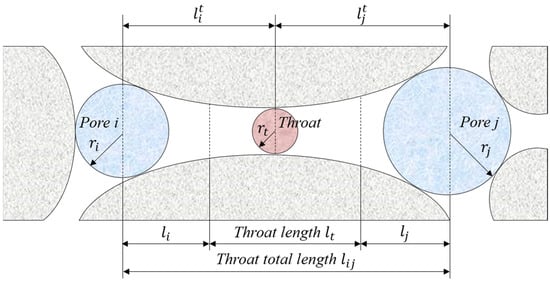
Figure 10.
Schematic of the length definition for pores and throats reproduced from [], with permission from American Physical Society, 2022.
Figure 11 shows the obtained stick-and-ball representation of the pore morphology when applying the maximum ball based extraction of pore network to the REV2 of each sample. The respective volumes of the “pore” (i.e., the balls) and the “throats” (i.e., the sticks) as well as their connectivity can be derived from the pore network model. More statistical details of the obtained pore-throat model are provided in Table 4.
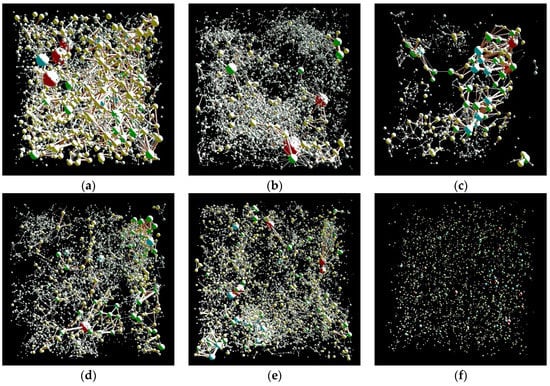
Figure 11.
Pore network model of REV2 of different samples. (a) Carbonate rock A. (b) Carbonate rock B. (c) Carbonate rock C. (d) Carbonate rock D. (e) Carbonate rock E. (f) Sandstone S.

Table 4.
Statistical results of pore network of REV2 of tested samples.
As can be seen from Table 4, carbonate samples had a much higher coordination number compared to the sandstone sample, indicating better connectivity between the pores. Moreover, the volume of pores in the carbonate samples is significantly higher than that of the sandstone sample. Among the carbonate samples, much higher porosity (see Table 3) and more large pores (see average radius of pores in Table 4) can be observed for sample A. As shown in Figure 11, the REVs of sample B, D and E contained a large number of evenly distributed and well-connected pores compared to the other carbonate samples. However, large pores were scarcer in samples B, D and E compared to samples A and C, which could be concluded from the smaller average radius/volume of pore for the former in Table 4. The number of pores in the REV of sample C was smaller than the counterparts of the others (see number of pores in Table 4) and the pores prevailed in the right half of the REV (see Figure 11c). The large average radius/volume of pore for sample C in Table 4 indicates the prevalence of large pores. As for the sandstone sample, a low coordination number and a small average radius/volume of pores were observed, suggesting small pores and bad connectivity between the pores.
5. Quantitative Analysis of Pore-Throat Network
The sizes and distribution of pores plays a vital role in determining the physical and mechanical properties of rock masses. In the following sections, detailed quantitative analysis is performed for the pore and the throat, respectively.
5.1. Quantitative Analysis of Pore
5.1.1. Pore Radius
Figure 12 shows the distribution of pore radius in the REVs of the carbonate samples, from which positive skewness was observed for all the samples. The pore radius of carbonate was primarily in the range of 20–500 μm. Choquette and Pray [] classified the pores of carbonate into megapores (4–256 mm), mesopores (0.0625–4 mm) and micropores (<0.0625 mm) based on the pore diameter. According to their classification, macropores are not existent in any of the REV2s of the carbonate samples. The majority of pores in the REVs are mesopores. The average radius of the pores is significantly larger for samples A and C compared to samples B, D and E.
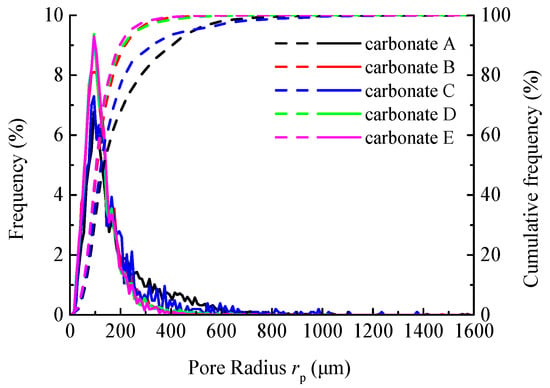
Figure 12.
Distribution of pore radius in the REV2s of carbonate samples.
A comparison for the distribution of pore radius between the sandstone and the carbonate is provided in Figure 13, where a confidence interval of 95% was imposed. As shown in Figure 13, the average pore radius of carbonate was much larger than that of sandstone. Using a scanning resolution of 61.75 μm for the carbonate samples, the observed minimum and maximum pore radii were 25 μm and 1600 μm,, respectively. Using a scanning resolution of 30.45 μm for the sandstone sample, the observed minimum and maximum pore radii were 12 μm and 146 μm, respectively. For both types of rock, megapores did not exist in the samples. The 95% confidence interval for the pore radius of sandstone was 10–80 μm (sample S), while for carbonate, it was 20–490 μm (sample A), 20–270 μm (sample B), 20–480 μm (sample C), 20–270 μm (sample D), 20–240 μm (sample E), respectively. This confirms a much wider range of pore radius for the carbonate compared to the sandstone. According to the classification of Choquette and Pray [], over 85% of the pores in carbonate samples are mesopores while more than 85% of pores in the sandstone sample are micropores.
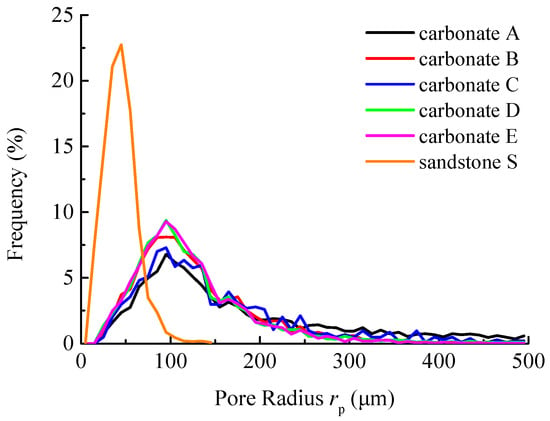
Figure 13.
Distribution of pore radius (95% confidence interval).
5.1.2. Pore Volume
Figure 14 shows the distribution of pore volume in the REV2s of all the rock samples. As can be seen, both the range of pore volume and the average pore volume were larger for the carbonate compared to the sandstone, indicating the prevalence of micropores in the sandstone. Among the pore volume distributions of the carbonate samples, four peaks were observed for samples A and C, while three peaks were observed for samples B, D and E, indicating the existence of relatively large pores in the former.
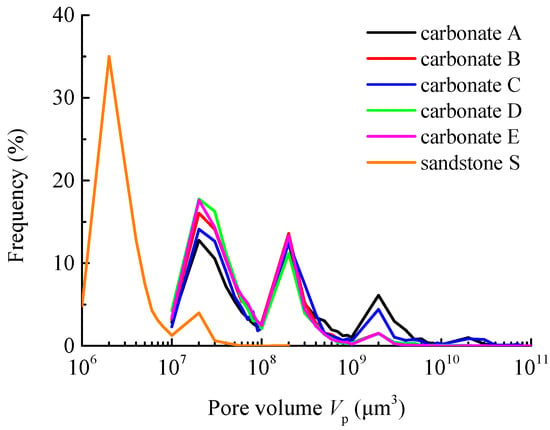
Figure 14.
Distribution of pore volume in the REV2s of test samples.
For the carbonate samples in Figure 14, the frequencies of the peaks decreased as the pore volume increased, indicating that small pores outnumbered large pores. The peaks in the distribution of pore volume of carbonate might be attributed to the size distribution of the grains, as grains of different sizes can form pores of different volumes during the sedimentary process. Large grains and poor gradation in carbonate can lead to large pore volumes. The peaks in the distribution of pore volume, which indicate pores of similar volume, may result from the sedimentation of grains with similar sizes. In the sandstone sample, the pore volume was not only small, but also prevailed in two orders of magnitude. This could be attributed to the small and uniform grain sizes as well as the compaction process when sandstone forms.
5.1.3. Pore Shape Factor
The shape factor G, which characterizes the shape of a pore, is defined as follows:
where A denotes the cross sectional area of a pore, P denotes the perimeter length of the cross section of a pore []. The shape factors of certain benchmark shapes of cross sections are: 0.0796 for a circle, 0.0722 for a regular hexagon, 0.0688 for a regular pentagon, 0.0625 for a square and 0.0481 for a regular triangle. As can be seen, the larger the value of the shape factor is, the more regular the shape of the cross section is. Figure 15 shows the distribution of shape factors for the pores in the carbonate and sandstone samples. Normal distribution was observed for the shape factor in all the samples. The values of the shape factor were primarily in the range of 0.015–0.045, indicating irregular triangular cross sections for the majority of pores. It can thus be inferred that the type of rock and the porosity have little effect on the shape of the pores.
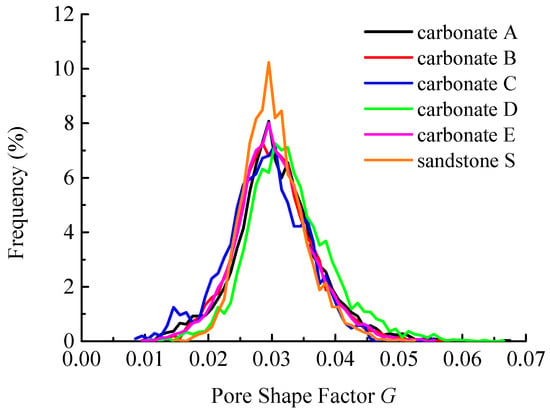
Figure 15.
Distribution of pore shape factor in REV2s of test samples.
5.2. Quantitative Analysis of Throat
5.2.1. Throat Radius
The throats serve as the connection between the pores and play a vital role in the permeability of rocks. Figure 16 shows the distribution of throat radius in the REVs of the carbonate samples, from which positive skewness was observed for all the samples. The throat radius of carbonate was primarily in the range of 0–200 μm. The average throat radius was smaller than the average pore radius (see Section 5.1.1). The average radius of throat was larger for samples A and C compared to samples B, D and E, similar to that observed for the average radius of pores in Section 5.1.1.
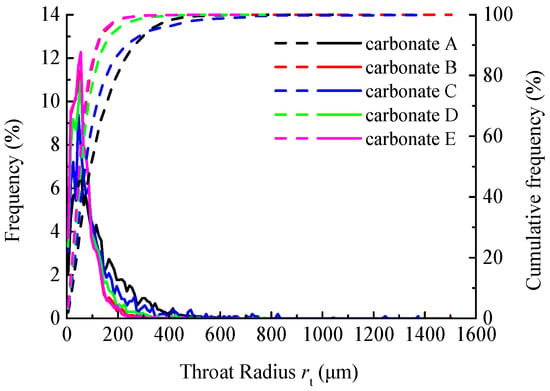
Figure 16.
Distribution of throat radius in REV2s of carbonate samples.
A comparison for the distribution of throat radius between the sandstone and the carbonate is provided in Figure 17, where a confidence interval of 95% was imposed. As shown in Figure 17, the average throat radius of carbonate was much larger than that of sandstone. The 95% confidence interval for the throat radius of sandstone was 0–60 μm (sample S), while for carbonate, it was 0–330 μm (samples A and C), 0–160 μm (samples B, D and E), respectively.
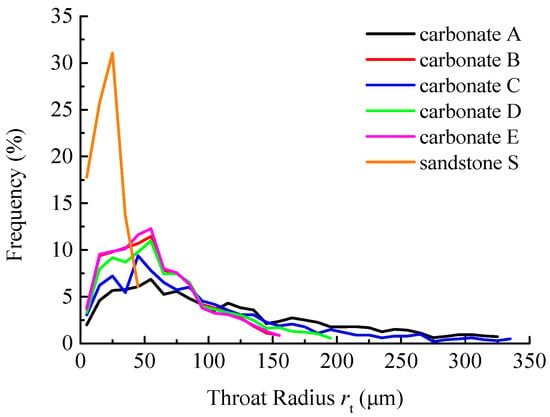
Figure 17.
Distribution of throat radius (95% confidence interval).
5.2.2. Throat Volume
Figure 18 shows the distribution of throat volume in the REV2s of all the rock samples. Among the throat volume distributions of the five carbonate samples, multiple peaks were observed. The throat volumes corresponding to the peaks were almost identical for all the carbonate samples, while the corresponding frequencies differed between the samples. For the REV2s of samples A and C, a small peak appeared when the throat volume was in the range of 109–2 × 109 μm3, which did not exist for the rest of the samples. Moreover, the frequency of the peak when the throat volume was in the range of 108–2 × 108 μm3 was significantly higher for samples A and C compared to the rest of the samples, indicating the prevalence of large throats in samples A and C. The range of throat volumes in the sandstone sample was narrower although multiple peaks were also observed. The throat volumes at the peaks were 2–3 orders of magnitude smaller than those of carbonate samples.
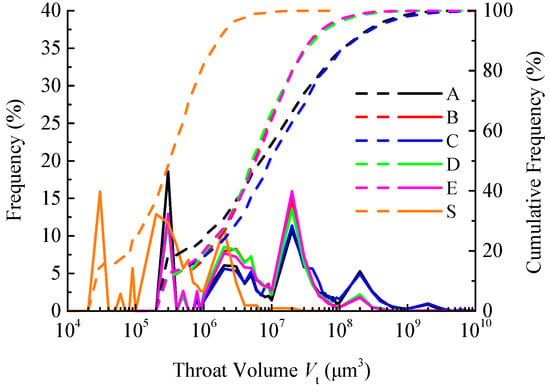
Figure 18.
Distribution of throat volume in the REV2s of test samples.
As for the curves of cumulative frequency in Figure 18, a similar trend could be observed for the carbonate and sandstone samples. Among the carbonate samples, the range of throat volumes of samples A and C were significantly larger than the rest. The throat volume of the sandstone sample was substantially smaller than that of the carbonate samples.
5.2.3. Throat Shape Factor
The factor of throat shape followed the same definition as the factor of pore shape in Section 5.1.3. The larger the value of the factor of throat shape, the more regular the shape of the cross section of the throat. Figure 19 shows the distribution of factors for the throat shape in the carbonate and sandstone samples. Normal distribution was observed for the shape factor in all the samples. The value of the shape factor was primarily in the range of 0.015–0.045, indicating irregular triangular cross sections for the majority of throats. By comparing Figure 15 and Figure 19, it can be seen that the distributions of the factors of pore and throat shape were similar. The type of rock and the porosity seem to have little effect on the shape of the throats.
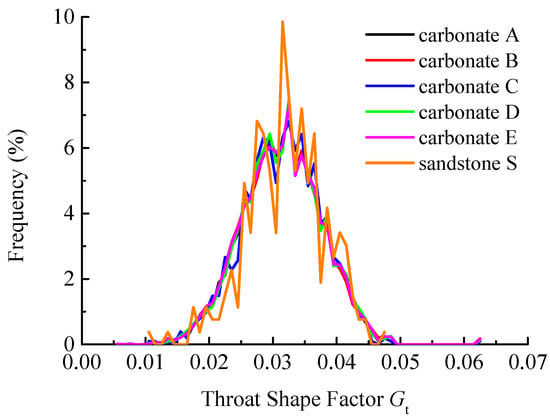
Figure 19.
Distribution of throat shape factors of REV2s of test samples.
5.2.4. Coordination Number
The coordination number refers to the number of throats connected to a single pore in the pore network. The larger the coordination number, the better the connectivity. As can be seen from Table 4, for the carbonate samples, the number of pores was approximately equal to the number of throats, leading to an average coordination number of 1. For the sandstone sample, the number of pores amounted to 2708 while the number of throats was merely 264, leading to an average coordination number of 0.1. Thus, the connectivity between pores is much worse for sandstone compared to carbonate.
In Table 4, the average volume of pore was larger than the average volume of throat for both sandstone and carbonate. The average volume of throat was approximately one order of magnitude smaller than the average volume of pore. For all the REVs in Table 4, the number of throats was either almost equal to or outnumbered by the number of pores. It can be thus inferred that the porosity of the REVs is majorly related to the volume of the pores.
In Table 4, the average radius of the pores was similar between sample A and C, as was the average volume of the pores. However, the REV of sample C contained only 1042 pores, in contrast to the 4335 pores in the REV of sample A. As a result, the porosity was higher for the REV of sample A. As for the carbonate samples B, D and E, their average radius of pore and average volume of pore were relatively small compared to their counterparts in sample C. However, samples B, D and E contained a larger number of pores compared to sample C. In the end, the porosity for the REV2s of samples B, C, D, E turned out to be similar (see Table 3). In summary, the number of pores, the radius of pore and the volume of pore are important factors affecting the porosity of a sample.
The average coordination number of the test rock samples and pore-throat network in the 3D model (Figure 11) are not contradictory. In Figure 11, in both of the pore-throat network models of marine carbonate rocks exist isolated pores, as well as the situation of multiple throats connected by a single pore. Therefore, the average coordinate number of marine carbonate rocks in Table 4 are accurate and reasonable. Owing to the number of throats being far fewer than the number of pores in the sandstone sample, therefore the average coordination number of it was 0.1, and the connectivity of the sandstone sample in Figure 11 was the worst, with the existence of a large number of isolated pores.
6. Conclusions
Using X-ray micro-CT, the present work investigates the pore-throat structure of five marine biogenic carbonate samples and a terrigenous sedimentary sandstone sample. As the results show, the five carbonate samples, which came from the drill cores at five different depths of a single drilling, differed significantly in porosity. On the whole, the research results were consistent with Yu et al. [] which also confirmed that the sedimentary law of coral reefs is different from that of terrigenous strata. In terrigenous strata, the physical and mechanical properties of rocks are usually enhanced with the increase in depth. However, coral reef strata have significant sedimentary facies belt effect and facies belt cycles. In this manuscript, the depth of the sampling did not influence the rock porosity significantly. This demonstrates the complex forming process of carbonate rocks, as the randomness of the sedimentary particulates and the heterogeneity of the diagenesis process result in anisotropic pore structures.
Cross sectional porosity was measured for the cross-sectional images of the samples in the direction of Z axis. Much higher cross sectional porosity was observed for the carbonate samples compared to the sandstone sample. Moreover, the deviation of cross-sectional porosity was more severe for the carbonate samples, indicating a more heterogeneous pore structure. In contrast, small and less deviative cross-sectional porosity was observed for the sandstone sample, indicating a relatively uniform and dense internal structure. How the cross-sectional porosity evolves along the Z axis reflects the change of porosity inside the specimen, which can help locate large pores in the sample in a non-disruptive manner.
A 3D reconstruction was performed for each rock sample using the cross-sectional images from CT scanning. Representative elementary volumes (REVs) at fixed positions of each rock sample were placed in the 3D reconstructed rock samples. The maximum ball algorithm was then applied to extract the pore-throat network of the REVs. As the results indicate, the average pore radius, the average pore volume, the average throat radius and the average throat volume of carbonate are not only larger than the counterparts of sandstone, but also distributed in a wider range compared to those of sandstone. Yet, similar distributions of the pore shape factors and the throat shape factors were observed between carbonate and sandstone. Over 85% of the pores in the carbonate samples were classified as mesopores while more than 85% of pores in the sandstone sample were deemed micropores. The average coordination number was 1 for carbonate, while 0.1 for sandstone.
As revealed in the present work, the average pore volume is larger than the average throat volume for both sandstone and carbonate. The average throat volume is approximately one order of magnitude smaller than the average pore volume. For all the scrutinized REVs, the number of throats were either almost equal to or outnumbered by the number of pores. It can be thus inferred that the porosity of the REVs is majorly related to the volume of the pores.
Author Contributions
Determine research goals and aims, creation of models, H.L. and C.Z.; data curation, writing—original draft, H.L. and C.M.; research funding support, H.L. and C.Z. All authors have read and agreed to the published version of the manuscript.
Funding
This research was funded by the National Key R&D Program of China grant number (2021YFC3100604), the National Natural Science Foundation of China grant numbers (41877271, 42107202) and the Natural Science Foundation of Hubei Province of China grant number (2020CFB243).
Data Availability Statement
Not applicable.
Acknowledgments
The authors also wish to acknowledge Professor Lizeng Bian, Nanjing University, for his help in interpreting the carbonate and sandstone microfacies.
Conflicts of Interest
The authors declare no conflict of interest.
References
- Ehrlich, R.; Kennedy, S.K.; Crabtree, S.J.; Cannon, R.L. Petrographic image analysis; I, Analysis of reservoir pore complexes. J. Sediment. Res. 1984, 54, 1365–1378. [Google Scholar] [CrossRef]
- Anselmetti, F.S.; Luthi, S.; Eberli, G.P. Quantitative characterization of carbonate pore systems by digital image analysis. AAPG Bull. 1998, 82, 1815–1836. [Google Scholar] [CrossRef]
- Liu, C.; Shi, B.; Zhou, J.; Tang, C.S. Quantification and characterization of microporosity by image processing, geometric measurement and statistical methods: Application on SEM images of clay materials. Appl. Clay Sci. 2011, 54, 97–106. [Google Scholar] [CrossRef]
- Xie, S.Y.; Cheng, Q.M.; Ling, Q.C.; Li, B.; Bao, Z.Y.; Fan, P. Fractal and multifractal analysis of carbonate pore-scale digital images of petroleum reservoirs. Mar. Pet. Geol. 2010, 27, 476–485. [Google Scholar] [CrossRef]
- Zhu, C.Q.; Chen, H.Y.; Meng, Q.S.; Wang, R. Microscopic characterization of intra-pore structures of calcareous sands. Rock Soil Mech. 2014, 35, 1831–1836. [Google Scholar] [CrossRef]
- Du, Y.J.; Jiang, N.J.; Liu, S.Y.; Jin, F.; Singh, D.N.; Puppala, A.J. Engineering properties and microstructural characteristics of cement-stabilized zinc-contaminated kaolin. Can. Geotech. J. 2014, 51, 289–302. [Google Scholar] [CrossRef]
- Wildenschild, D.; Sheppard, A.P. X-ray imaging and analysis techniques for quantifying pore-scale structure and processes in subsurface porous medium systems. Adv. Water Resour. 2013, 51, 217–246. [Google Scholar] [CrossRef]
- Arns, C.H.; Bauget, F.; Limaye, A.; Sakellariou, A.; Senden, T.J.; Sheppard, A.P.; Sok, R.; Pinczewski, V.; Bakke, S.; Berge, L.I.; et al. Pore scale characterisation of carbonates using X-ray microtomography. In Proceedings of the SPE Annual Technical Conference and Exhibition, Houston, TX, USA, 26–29 September 2004. [Google Scholar] [CrossRef]
- Coenen, J.; Tchouparova, E.; Jing, X. Measurement parameters and resolution aspects of micro X-ray tomography for advanced core analysis. In Proceedings of the International Symposium of the Society of Core Analysts, Abu Dhabi, United Arab Emirates, 5–9 October 2004. [Google Scholar]
- Blunt, M.J.; Bijeljic, B.; Dong, H.; Gharbi, O.; Iglauer, S.; Mostaghimi, P.; Paluszny, A.; Pentland, C. Pore-scale imaging and modelling. Adv. Water Resour. 2013, 51, 197–216. [Google Scholar] [CrossRef]
- Zeng, L.B.; Jiang, J.W.; Yang, Y.L. Fractures in the low porosity and ultra-low permeability glutenite reservoirs: A case study of the late Eocene Hetaoyuan formation in the Anpeng Oilfield, Nanxiang Basin, China. Mar. Pet. Geol. 2010, 27, 1642–1650. [Google Scholar] [CrossRef]
- Zhao, H.; Zhao, Y.X. An automatic loading system for rock core testing with an industrial CT scanner. Pet. Sci. 2011, 8, 490–493. [Google Scholar] [CrossRef][Green Version]
- Fonseca, J.; O’sullivan, C.; Coop, M.R.; Lee, P.D. Quantifying the evolution of soil fabric during shearing using scalar parameters. Geotechnique 2013, 63, 818–829. [Google Scholar] [CrossRef]
- Wang, Y.; Li, X.; Zhang, B.; Wu, Y.F. Meso-damage cracking characteristics analysis for rock and soil aggregate with CT test. Sci. China-Technol. Sci. 2014, 57, 1361–1371. [Google Scholar] [CrossRef]
- Wang, Y.; Miller, J.D. Current developments and applications of micro-CT for the 3D analysis of multiphase mineral systems in geometallurgy. Earth-Sci. Rev. 2020, 211, 103406. [Google Scholar] [CrossRef]
- Wu, J.; Fan, T.L.; Gomez-Rivas, E.; Gao, Z.Q.; Yao, S.Q.; Li, W.H.; Zhang, C.J.; Sun, Q.Q.; Gu, Y.; Xiang, M. Impact of pore structure and fractal characteristics on the sealing capacity of Ordovician carbonate cap rock in the Tarim Basin, China. Mar. Pet. Geol. 2019, 102, 557–579. [Google Scholar] [CrossRef]
- Raeini, A.Q.; Blunt, M.J.; Bijeljic, B. Direct simulations of two-phase flow on micro-CT images of porous media and upscaling of pore-scale forces. Adv. Water Resour. 2014, 74, 116–126. [Google Scholar] [CrossRef]
- Cnudde, V.; Boone, M.N. High-resolution X-ray computed tomography in geosciences: A review of the current technology and applications. Earth-Sci. Rev. 2013, 123, 1–17. [Google Scholar] [CrossRef]
- Wu, Y.Q.; Tahmasebi, P.; Lin, C.Y.; Zahid, M.A.; Dong, C.M.; Golab, A.N.; Ren, L.H. A comprehensive study on geometric, topological and fractal characterizations of pore systems in low-permeability reservoirs based on SEM, MICP, NMR, and X-ray CT experiments. Mar. Pet. Geol. 2019, 103, 12–28. [Google Scholar] [CrossRef]
- Fan, X.Q.; Wang, G.W.; Li, Y.F.; Dai, Q.Q.; Song, L.H.; Duan, C.W.; Zhang, C.G.; Zhang, F.S. Pore structure evaluation of tight reservoirs in the mixed siliciclastic-carbonate sediments using fractal analysis of NMR experiments and logs. Mar. Pet. Geol. 2019, 109, 484–493. [Google Scholar] [CrossRef]
- Weger, R.J.; Eberli, G.P.; Baechle, G.T.; Massaferro, J.L.; Sun, Y.F. Quantification of pore structure and its effect on sonic velocity and permeability in carbonates. AAPG Bull. 2009, 93, 1297–1317. [Google Scholar] [CrossRef]
- Zhu, C.Q.; Liu, H.F.; Zhou, B. Micro-structures and the basic engineering properties of beach calcarenites in South China Sea. Ocean Eng. 2016, 114, 224–235. [Google Scholar] [CrossRef]
- Liu, H.F.; Zhu, C.Q.; Wang, R.; Cui, X.; Wang, T.M. Characterization of the interface between concrete pile and coral reef calcarenite using constant normal stiffness direct shear test. Bull. Eng. Geol. Environ. 2021, 80, 1757–1765. [Google Scholar] [CrossRef]
- Liu, H.F.; Zhu, C.Q.; Zheng, K.; Ma, C.H.; Yi, M.X. Crack Initiation and Damage Evolution of Micritized Framework Reef Limestone in the South China Sea. Rock Mech. Rock Eng. 2021, 54, 5591–5601. [Google Scholar] [CrossRef]
- Choquette, P.W.; Pray, L.C. Geologic nomenclature and classification of porosity in sedimentary carbonates. AAPG Bull. 1970, 54, 207–250. [Google Scholar] [CrossRef]
- Ulusay, R. (Ed.) The ISRM Suggested Methods for Rock Characterization, Testing and Monitoring: 2007–2014; Springer International Publishing: Cham, Switzerland, 2015. [Google Scholar] [CrossRef]
- Fatt, I. The network model of porous media. Trans. AIME 1956, 207, 144–181. [Google Scholar] [CrossRef]
- Dong, H.; Fjeldstad, S.; Alberts, L.; Roth, S.; Bakke, S.; Øren, P.E. Pore network modelling on carbonate: A comparative study of different micro-CT Network extraction methods. In Proceedings of the International Symposium of the Society of Core Analysts, Abu Dhabi, United Arab Emirates, 18–22 October 2008. [Google Scholar]
- Øren, P.E.; Bakke, S. Process based reconstruction of sandstones and prediction of transport properties. Transp. Porous Media 2002, 46, 311–343. [Google Scholar] [CrossRef]
- Silin, D.B.; Jin, G.; Patzek, T.W. Robust determination of the pore space morphology in sedimentary rocks. In Proceedings of the SPE Annual Technical Conference and Exhibition, Denver, CO, USA, 5–8 October 2003. [Google Scholar] [CrossRef]
- Silin, D.; Patzek, T. Pore space morphology analysis using maximal inscribed spheres. Phys. A Stat. Mech. Its Appl. 2006, 371, 336–360. [Google Scholar] [CrossRef]
- Al-Kharusi, A.S.; Blunt, M.J. Network extraction from sandstone and carbonate pore space images. J. Pet. Sci. Eng. 2007, 56, 219–231. [Google Scholar] [CrossRef]
- Dong, H.; Blunt, M.J. Pore-network extraction from micro-computerized-tomography images. Phys. Rev. E 2009, 80, 036307. [Google Scholar] [CrossRef] [PubMed]
- Mason, G.; Morrow, N.R. Capillary behavior of a perfectly wetting liquid in irregular triangular tubes. J. Colloid Interface Sci. 1991, 141, 262–274. [Google Scholar] [CrossRef]
- Yu, K.F. Introduction to the Science of Coral Reefs; Science Press: Beijing, China, 2018. [Google Scholar]
Publisher’s Note: MDPI stays neutral with regard to jurisdictional claims in published maps and institutional affiliations. |
© 2022 by the authors. Licensee MDPI, Basel, Switzerland. This article is an open access article distributed under the terms and conditions of the Creative Commons Attribution (CC BY) license (https://creativecommons.org/licenses/by/4.0/).